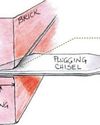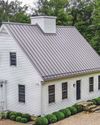
Old houses often have pocket doors between main rooms, as a way of opening the space or creating privacy. They fell out of favor in part because of their reputation for sticking or jumping the track. New pocket-door kits have a smooth roller operation, and the ready-made frames make installation easier. Today we’re more likely to install them in such tight or small spaces as a bathroom or pantry, where the arc of a door swing would be awkward. With some TLC, a salvaged door (or one original to the house) can be rehung to slide into a pocket. Pocket-door kits are for doors 1 1 /8 to 1 ¾ thick. Modern track systems are made of aluminum—lightweight and stable. Wheel assemblies in the hanger roll on nylon wheels with ball bearings for smooth, quiet operation. A bumper at the rear of the frame keeps the door from sliding too far into the wall. Floor anchors keep it from rattling and maintain a proper distance between split jambs. Check that the kit's header is the right size for supporting the weight of the door. Supported weight can range from 75 to 175 pounds. Look for removable roller tracks that are jump-proof. The nylon wheels should be at least 1 or larger, and self-leveling. Look for four wheels per hanger; three-wheel systems are less stable.
You need two flush pulls and a recessed edge faceplate with a pull. When choosing pulls, consider whether the door will need a locking option. C-notch pulls are easy to install and affordable, but the small locking mechanism in the handle may be hard to operate. Mortise sets often function easier, but installation is more complicated.
Diese Geschichte stammt aus der October - November 2020-Ausgabe von Old House Journal.
Starten Sie Ihre 7-tägige kostenlose Testversion von Magzter GOLD, um auf Tausende kuratierte Premium-Storys sowie über 8.000 Zeitschriften und Zeitungen zuzugreifen.
Bereits Abonnent ? Anmelden
Diese Geschichte stammt aus der October - November 2020-Ausgabe von Old House Journal.
Starten Sie Ihre 7-tägige kostenlose Testversion von Magzter GOLD, um auf Tausende kuratierte Premium-Storys sowie über 8.000 Zeitschriften und Zeitungen zuzugreifen.
Bereits Abonnent? Anmelden

faded luxe IN A RETURN TO SAVANNAH
Residents of the Blue Ridge Mountains find their city home in a converted commercial building in beautiful Savannah, Georgia.

a hudson valley VERNACULAR
When Harlan Bratcher started looking for a country house in New York, in 1990, he knew what he wanted-something peaceful and serene, an escape from the hectic lifestyle of Manhattan.

the Dr. Mills house RESTORED
In rural Washington State, a dedicated couple bring back a 1912 bungalow that once had been the town's hospital.

The Right Masonry Tool for Repointing
The mortar between individual bricks or stones begins to erode after many years. That might be attributed to rain and wind, leaky gutters, building settlement, or such chemical agents as de-icing salts.

How To Remove Wallpaper
There's more than one way to do it; try them all until you find what works for your situation.

living with PLASTICS anxiety
Plastics are ubiquitous in modern life. Even houses built long before vinyl caught on are now full of polymer-based products, from the hoses in pull-down faucets to plastic light switches. Now that we know exposure to certain plastics can be hazardous to human health, we need guidance on how to evaluate building products for potential impacts.

homey Craftsman Textiles today
For bungalows, Craftsman houses, and Tudors that might have rather severe woodwork and furniture, textiles are a critical part of the decorative scheme.

Navigating the Lumberyard - Here's some lumber lingo you should know before you venture into a lumberyard.
Here's some lumber lingo you should know before you venture into a lumberyard. Almost everyone fixing an old house will end up at a lumberyard-whether it's a local supplier or the organized aisles of a big-box home-improvement store.

a farmhouse renewed
Sensitive renovations and restoration work preserved a house that dates to 1799.

AN OVERVIEW OF METAL ROOFING
METAL ROOFS ARE RESURGENT, FOR GOOD REASONS.